The AMD Radeon R9 Fury X Review: Aiming For the Top
by Ryan Smith on July 2, 2015 11:15 AM ESTCompute
Shifting gears, we have our look at compute performance. As an FP64 card, the R9 Fury X only offers the bare minimum FP64 performance for a GCN product, so we won’t see anything great here. On the other hand with a theoretical FP32 performance of 8.6 TFLOPs, AMD could really clean house on our more regular FP32 workloads.
Starting us off for our look at compute is LuxMark3.0, the latest version of the official benchmark of LuxRender 2.0. LuxRender’s GPU-accelerated rendering mode is an OpenCL based ray tracer that forms a part of the larger LuxRender suite. Ray tracing has become a stronghold for GPUs in recent years as ray tracing maps well to GPU pipelines, allowing artists to render scenes much more quickly than with CPUs alone.
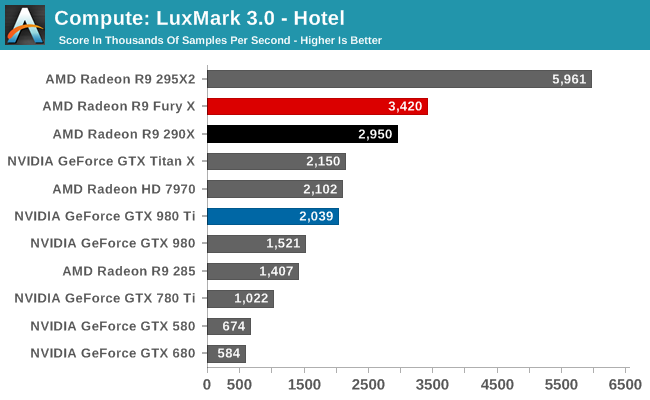
The results with LuxMark ended up being quite a bit of a surprise, and not for a good reason. Compute workloads are shader workloads, and these are workloads that should best illustrate the performance improvements of R9 Fury X over R9 290X. And yet while the R9 Fury X is the fastest single GPU AMD card, it’s only some 16% faster, a far cry from the 50%+ that it should be able to attain.
Right now I have no reason to doubt that the R9 Fury X is capable of utilizing all of its shaders. It just can’t do so very well with LuxMark. Given the fact that the R9 Fury X is first and foremost a gaming card, and OpenCL 1.x traction continues to be low, I am wondering whether we’re seeing a lack of OpenCL driver optimizations for Fiji.
For our second set of compute benchmarks we have CompuBench 1.5, the successor to CLBenchmark. CompuBench offers a wide array of different practical compute workloads, and we’ve decided to focus on face detection, optical flow modeling, and particle simulations.
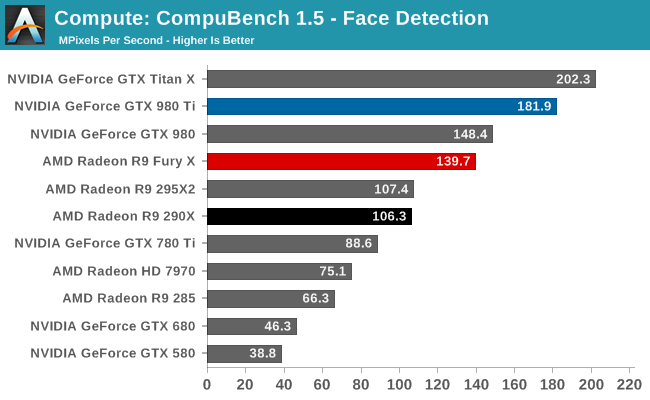
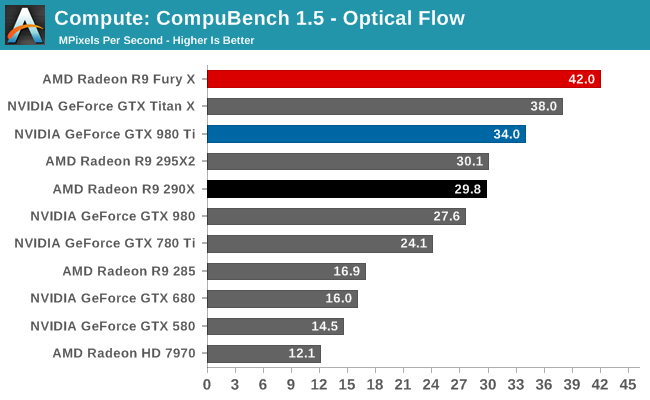

Quickly taking some of the air out of our driver theory, the R9 Fury X’s performance on CompuBench is quite a bit better, and much closer to what we’d expect given the hardware of the R9 Fury X. The Fury X only wins overall at Optical Flow, a somewhat memory-bandwidth heavy test that to no surprise favors AMD’s HBM additions, but otherwise the performance gains across all of these tests are 40-50%. Overall then the outcome over who wins is heavily test dependent, though this is nothing new.
Our 3rd compute benchmark is Sony Vegas Pro 13, an OpenGL and OpenCL video editing and authoring package. Vegas can use GPUs in a few different ways, the primary uses being to accelerate the video effects and compositing process itself, and in the video encoding step. With video encoding being increasingly offloaded to dedicated DSPs these days we’re focusing on the editing and compositing process, rendering to a low CPU overhead format (XDCAM EX). This specific test comes from Sony, and measures how long it takes to render a video.
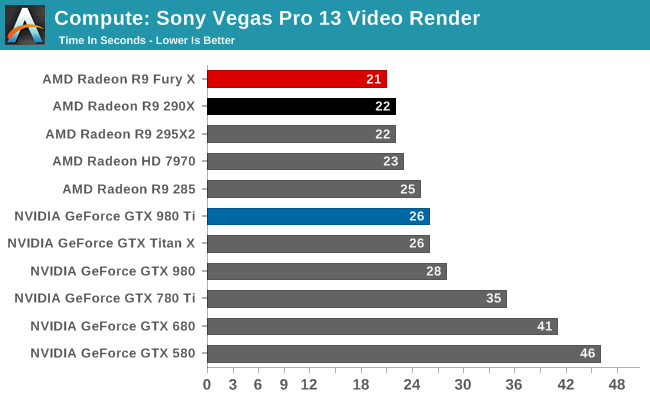
At this point Vegas is becoming increasingly CPU-bound and will be due for replacement. The Fury X none the less shaves off an additional second of rendering time, bringing it down to 21 seconds.
Moving on, our 4th compute benchmark is FAHBench, the official Folding @ Home benchmark. Folding @ Home is the popular Stanford-backed research and distributed computing initiative that has work distributed to millions of volunteer computers over the internet, each of which is responsible for a tiny slice of a protein folding simulation. FAHBench can test both single precision and double precision floating point performance, with single precision being the most useful metric for most consumer cards due to their low double precision performance. Each precision has two modes, explicit and implicit, the difference being whether water atoms are included in the simulation, which adds quite a bit of work and overhead. This is another OpenCL test, utilizing the OpenCL path for FAHCore 17.
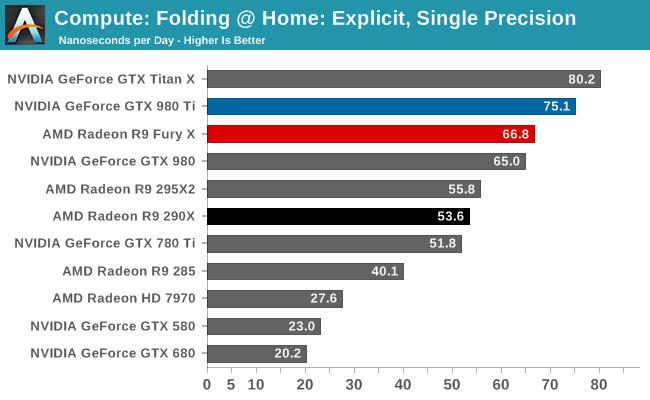

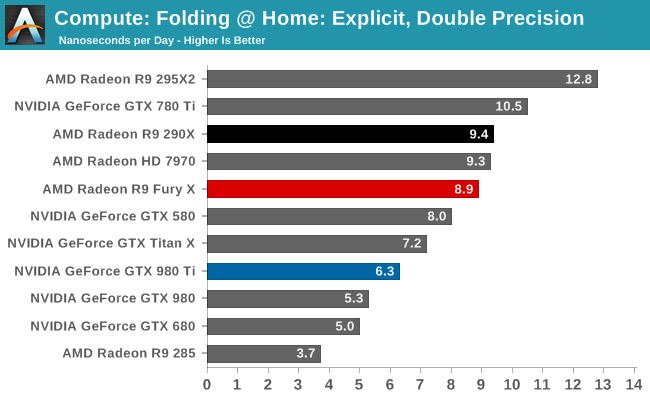
Both of the FP32 tests for FAHBench show smaller than expected performance gains given the fact that the R9 Fury X has such a significant increase in compute resources and memory bandwidth. 25% and 34% respectively are still decent gains, but they’re smaller gains than anything we saw on CompuBench. This does lend a bit more support to our theory about driver optimizations, though FAHBench has not always scaled well with compute resources to begin with.
Meanwhile FP64 performance dives as expected. With a 1/16 rate it’s not nearly as bad as the GTX 900 series, but even the Radeon HD 7970 is beating the R9 Fury X here.
Wrapping things up, our final compute benchmark is an in-house project developed by our very own Dr. Ian Cutress. SystemCompute is our first C++ AMP benchmark, utilizing Microsoft’s simple C++ extensions to allow the easy use of GPU computing in C++ programs. SystemCompute in turn is a collection of benchmarks for several different fundamental compute algorithms, with the final score represented in points. DirectCompute is the compute backend for C++ AMP on Windows, so this forms our other DirectCompute test.
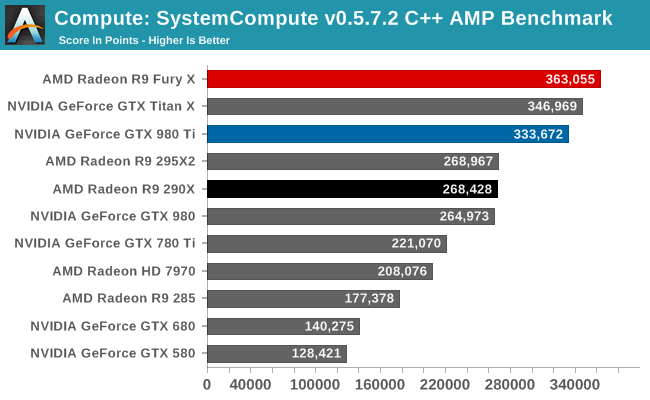
Our C++ AMP benchmark is another case of decent, though not amazing, GPU compute performance gains. The R9 Fury X picks up 35% over the R9 290X. And in fact this is enough to vault it over NVIDIA’s cards to retake the top spot here, though not by a great amount.










458 Comments
View All Comments
looncraz - Friday, July 3, 2015 - link
We don't yet know how the Fury X will overclock with unlocked voltages.SLI is almost just as unreliable as CF, ever peruse the forums? That, and quite often you can get profiles from the wild wired web well before the companies release their support - especially on AMD's side.
chizow - Friday, July 3, 2015 - link
@looncrazWe do know Fury X is an exceptionally poor overclocker at stock and already uses more power than the competition. Who's fault is it that we don't have proper overclocking capabilities when AMD was the one who publicly claimed this card was an "Overclocker's Dream?" Maybe they meant you could Overclock it, in your Dreams?
SLI is not as unreliable as CF, Nvidia actually offers timely updates on Day 1 and works with the developers to implement SLI support. In cases where there isn't a Day 1 profile, SLI has always provided more granular control over SLI profile bits vs. AMD's black box approach of a loadable binary, or wholesale game profile copies (which can break other things, like AA compatibility bits).
silverblue - Friday, July 3, 2015 - link
No, he did actually mention the 980Ti's excellent overclocking ability. Conversely, at no point did he mention Fury X's overclocking ability, presumably because there isn't any.Refuge - Friday, July 3, 2015 - link
He does mention it, and does say that it isn't really possible until they get modified bios with unlocked voltages.e36Jeff - Thursday, July 2, 2015 - link
first off, its 81W, not 120W(467-386). Second, unless you are running furmark as your screen saver, its pretty irrelevant. It merely serves to demonstrate the maximum amount of power the GPU is allowed to use(and given that the 980 Ti's is 1W less than in gaming, it indicates it is being artfically limited because it knows its running furmark).The important power number is the in game power usage, where the gap is 20W.
Ryan Smith - Thursday, July 2, 2015 - link
There is no "artificial" limiting on the GTX 980 Ti in FurMark. The card has a 250W limit, and it tends to hit it in both games and FurMark. Unlike the R9 Fury X, NVIDIA did not build in a bunch of thermal/electrical headroom in to the reference design.kn00tcn - Thursday, July 2, 2015 - link
because furmark is normal usage right!? hbm magically lowers the gpu core's power right!? wtf is wrong with younandnandnand - Thursday, July 2, 2015 - link
AMD's Fury X has failed. 980 Ti is simply better.In 2016 NVIDIA will ship GPUs with HBM version 2.0, which will have greater bandwidth and capacity than these HBM cards. AMD will be truly dead.
looncraz - Friday, July 3, 2015 - link
You do realize HBM was designed by AMD with Hynix, right? That is why AMD got first dibs.Want to see that kind of innovation again in the future? You best hope AMD sticks around, because they're the only ones innovating at all.
nVidia is like Apple, they're good at making pretty looking products and throwing the best of what others created into making it work well, then they throw their software into the mix and call it a premium product.
Intel hasn't innovated on the CPU front since the advent of the Pentium 4. Core * CPUs are derived from the Penitum M, which was derived from the Pentium Pro.
Kutark - Friday, July 3, 2015 - link
Man you are pegging the hipster meter BIG TIME. Get serious. "Intel hasn't innovated on the CPU front since the advent of the Pentium 4..." That has to be THE dumbest shit i've read in a long time.Say what you will about nvidia, but maxwell is a pristinely engineered chip.
While i agree with you that AMD sticking around is good, you can't be pissed at nvidia if they become a monopoly because AMD just can't resist buying tickets on the fail train...